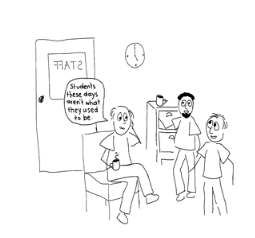Assessing students' LLN in VET
Generic assessments are not effective!
Every vocational course is different in terms of the level and kind of LLN required at entry as well as during the program. For example, some VET courses require an understanding of higher level Maths and so a numeracy test which assessed only competency in the four basic operations of addition, subtraction, multiplication and division would obviously be inappropriate.
Similarly some VET courses are more language intensive than others. For example competencies in Business Law in the Financial Services training package require students to learn new and difficult legal terminology and to analyse and argue a response to a legal case study require higher level language and literacy skills than perhaps students embarking on a retail traineeship. By the same token it would be pointless give a complex reading task say using an Age feature article to students embarking on a trade apprenticeship. These students will need to understand and learn a whole lot of new trade language and quite technical procedures but they won’t need to critically analyse a writer’s arguments.

Make the test fit the competencies of the course
Pre-entry assessments need to be customised
An important principle for any LLN assessment in VET is that it is customised for the competencies required for any particular VET program and it may be helpful to seek the assistances of LLN specialist in your institute. You will see the texts and tasks included in the test are related to the course of study but do not require specific prior knowledge. You may also see that the skills assessed are all skills that will be needed by students in order to undertake the course. Necessary LLN skills include, the ability to:
- read documents relevant to the subject matter of the course of study
- interpret graphs and charts that relate to the course content,
- perform simple but related calculations and measurements in course related contexts
- write sufficiently to undertake the tasks of the profession.
Those skills chosen to include in the assessment are those which the teacher knows, from her experience, can prove difficult to the students. The aim of the test is to gain a broad picture of the number of students who may need support and in what areas. From that information, planning decisions can be made about the appropriate methods of support.

Pre entry tests & tasks need to be related to the VET course but they should not require prior knowledge
Non-formal options for LLN assessments
Formal tests are very intimidating for students. If it is possible it is a good idea to use less formal means of assessing the LLN needs of students at pre entry. In fact you are more likely to gain an accurate assessment of student’s current LLN skills if they are relaxed and responsive to the assessment. For example a short literacy writing assessment could be part of the part of the enrolments process with a requirement for a written response (½ page – one page depending on the level of the course) to the questions like:
- How did you come to choose this course?
OR
- What do you see yourself doing in five years time?
Some other effective methods of assessing LLN skills pre entry or in initial VET program classes are described below.
Interviews
Although interviews are time intensive, they can provide valid and useful information about pre entry LLN skills of your students. Questions about educational background assist teachers in identifying students who may need additional LLN support with their course. LLN issues related to interrupted schooling history, non completion of secondary education or non completion of requisite subjects like Maths at year 11 or 12 for example, for an electrical apprenticeship, can indicate students who will require extra or targeted support to successfully complete their VET program.
It is also possible to follow up the initial part of an interview by asking students some questions that target critical skills identified by the staff as potential problems for students later in the course. Such interview assessment techniques should start gradually, so that students can exhibit skills they do have and gain confidence whilst leading them to the critical skill areas.

Target critical skills required for the course
Self assessment checklists
Students (particularly post entry) usually do not over estimate their own skills. Giving students a one page checklist containing statements which cover the underpinning competencies of your VET program which students are required to respond to allows students to reflect on their current skills as well as the skills they are required to develop to successfully complete their chosen VET program. LLN skills and perhaps also the current learning and study skills is invaluable for VET teacher trainers in program and course planning as strategic support and LLN skills development can be integrated into the VET program prior to the first assessment or assignment.
Observation
As well as analysing the results of any formal or non formal assessment you can also gain very useful information about LLN skills by observing how students are responding to either an assessment or even the enrolment process. LLN support needs may also be indicated by the length of time any assessment or enrolment process is taking students.
A letter to students
In the initial session of a VET program introductory activities could include a letter to students introducing yourself (could include family, likes, work history etc.) which students are required to read and then answer in a similar format and length ect. Because students are required to read the letter and then reply using their teacher’s letter as a model for their own it is possible to use an introductory ‘getting to know you activity’ as an informal tool for assessing LLN.
